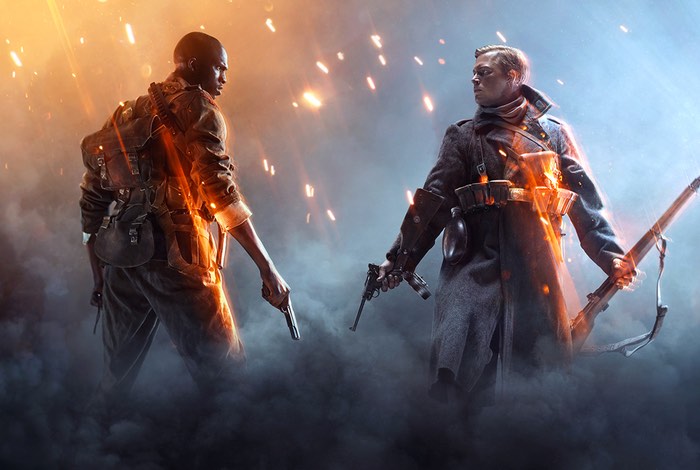Battlefield 1's voice actors played catch with cinderblocks while recording their lines
The struggle is real, apparently.

War—and probably World War I in particular—is hell. A cozy, insulated recording studio in Stockholm, Sweden is not hell. How does Battlefield 1 developer DICE get its voice actors to capture the adrenaline and arduousness of war?
In a talk called "Redefining the Sound of the Great War" at the Game Developers Conference this week, DICE outlined its approach to creating authentic audio for Battlefield 1. That approach included a peculiar technique known to DICE as "the cinderblock method": burdening actors with weight and making them play catch with cinderblocks as they deliver lines.
"To keep [actors] coherent in terms of direction and performance, Victor, our voiceover designer, had to sort of devise a new method with very specific requirements on the actors' performance so that the localization. It's essentially backpacks full of weights that we put on the actors, and then we have a cinderblock, and we just launch them between the actors when they're delivering lines. There are more nuances, it should actually be its own talk because it's really, really cool," said Andreas Almström, lead sound designer on Battlefield 1.
Above: A montage of weapon and vehicle recording sessions shown during DICE's presentation, featuring Andreas Almström (bearded) and Bence Pajor.
"This creates physical strain and labor, and that fits our world completely perfectly, since in Battlefield, ninety-nine percent of the time people are running around, vaulting, throwing hand grenades and shouting. So it makes little sense for us not to have physicality involved in the actual performance." The hour-long panel shed light on how DICE's process for recording weapons has changed since Battlefield 2, the first game that DICE attempted live, original weapon recordings. DICE games are widely praised for their sound, but audio director Bence Pajor took the opportunity to criticize some of the studio's earlier work.
"Bad Company [1] was primarily done for the new generation of consoles … and we knew it was going to be played back from TVs. We wanted our game to feel loud and violent on a small, crappy TV speaker with a very limited dynamic range," said Pajor. "Our main inspiration was YouTube. There was a lot of combat footage on YouTube and on the news from the war in Iraq, and that sounded just crazy loud and intense and chaotic and scary. And also it didn't sound like any film we'd ever heard." With internet war footage as one of its inspirations for Bad Company in 2008, DICE employed another interesting technique to test its creative direction: superimposing game sounds onto real combat footage sourced from YouTube.
"The only reference material we had was in written form, because there are no recordings from this time."
Bence Pajor, audio director, on BF1
As the Battlefield series evolved, so did DICE's thinking about sound design. By 2013, for instance, Pajor says they'd began to exercise more restraint around how bass was used. "Battlefield 4 … we felt it needed a bit more edge to it. More brutality. So we started applying stricter rules to the sound design process. We'd been analyzing Battlefield 3 a lot, and felt that one thing that could throw off the balance sometimes was unnecessary use of bass or low frequencies in sounds that didn't require it. We felt that in Battlefield, bass is the currency of power, so we must spend it carefully," said Pajor. "So for example if an ambient or foley sound has a lot of low level, it will saturate the air with low-end frequencies, and you sort of get used to hearing those frequencies. When an explosion or gunshot goes off, the frequencies they share tend to get lost in the low-end noise. So you only hear that sort of tip of the iceberg from the explosion. A lot of the nice, low ones we put in [Battlefield 3] were just lost."
The biggest gaming news, reviews and hardware deals
Keep up to date with the most important stories and the best deals, as picked by the PC Gamer team.
For DICE's sound designers, Battlefield 1 represented a frontier for DICE. The studio was focused on authenticity and immersion, but for the first time they had no existing recordings or popular media to use as a starting point. "We'd always had tons of reference material, either from the real world or movies," said Pajor. "And we always used that as a tool to position our own prototype. If there was a big, epic, defining film, we would say 'Build sounds like this, what should we do then?' But here [in Battlefield 1], we had nothing to relate to. There aren't any big, defining World War I war movies. And the only reference material we had was in written form, because there are no recordings from this time.
Above: A technical breakdown of how Battlefield 1 modularly produces explosion sounds based on the player's position and distance.
"We had no real sound cliches that we could use, as like radio communication which is an instant mood setter, you can always tell by the radio chatter if it's World War II, or a modern conflict. These things are super established in films. But we had nothing. There are the typical M1 tanks with the turbine engines, we had no WW2 Stukas, no missiles, no electronic targeting systems, no Kevlar, no velcro, no helicopters, no Jimi Hendrix. There was nothing. We felt a bit on our own. The one thing that we did know through market research was that the preconception about World War I is that it must be super slow, super boring, and mustard gas, trench foot, agony, just the worst things. So we felt that we had a chance to redefine that."
Almström added that DICE looked to written material as a source of inspiration: "So we read a lot of letters from just young soldiers writing home to their mothers. And they would just describe the sounds of war with stuff they could relate to. A French soldier said that the French 75 mm cannon sounded like 'a sharp, sort of wood block chop sound'. And when the shell goes over, it sounds like 'a very peculiar whine, not unlike a cat.'"
One final detail DICE shared was that despite moving from using local voice talent to professional voice talent over the lifespan of the Battlefield series, all of the death screams for Battlefield 1 are recorded by DICE itself. Evidence of this is captured in this video montage shown during the presentation.

Evan's a hardcore FPS enthusiast who joined PC Gamer in 2008. After an era spent publishing reviews, news, and cover features, he now oversees editorial operations for PC Gamer worldwide, including setting policy, training, and editing stories written by the wider team. His most-played FPSes are CS:GO, Team Fortress 2, Team Fortress Classic, Rainbow Six Siege, and Arma 2. His first multiplayer FPS was Quake 2, played on serial LAN in his uncle's basement, the ideal conditions for instilling a lifelong fondness for fragging. Evan also leads production of the PC Gaming Show, the annual E3 showcase event dedicated to PC gaming.

